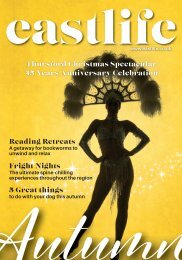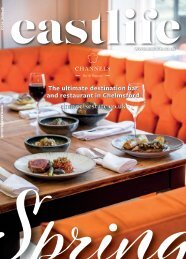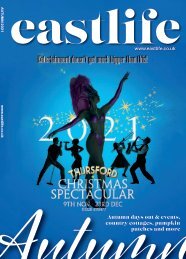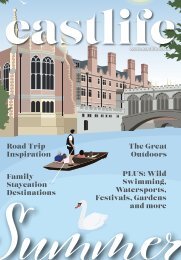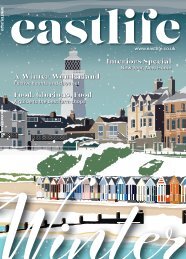Eastlife Spring 2020
With spring flowers, warmer weather and Easter on the horizon, we’re helping you get out of the winter slumber and embrace the great outdoors. Spend the afternoon exploring the sleepy villages of Norfolk or Suffolk, learn to sail on the Broads or punt along the River Cam. Find out more about beach hut hire on the pretty shores of Mersea Island or discover the likes of Ely, Colchester and Ipswich with our travel guides.
With spring flowers, warmer weather and Easter on the horizon, we’re helping you get out of the winter slumber and embrace the great outdoors. Spend the afternoon exploring the sleepy villages of Norfolk or Suffolk, learn to sail on the Broads or punt along the River Cam. Find out more about beach hut hire on the pretty shores of Mersea Island or discover the likes of Ely, Colchester and Ipswich with our travel guides.
You also want an ePaper? Increase the reach of your titles
YUMPU automatically turns print PDFs into web optimized ePapers that Google loves.
PROPERTY
Images by Judith Wakelam
Swifts in other places
St Mary’s Ely is just one church with a vibrant swift colony,
there are also substantial colonies in the belfries of All Saints’
Worlington, St John’s Bury St Edmunds, St Mary the Virgin in St
Neots, All Saints’ Landbeach and St Vigor’s Fulbourn.
“Solving the insect problem is difficult, but at
some stage will be of paramount importance, if
we humans as a species are to survive”
Fulbourn; Swift Central
Originally, the houses in Haggis Gap, Fulbourn housed about
70 pairs of swifts. When these houses were replaced by ‘The
Swifts’ housing estate, the developers included nearly 300 nest
boxes for swifts. Today there are over a 100 pairs of swifts and
quite a few house sparrows and house martins living in these
nest boxes.
The Cambridge Swift Tower
The Cambridge swift tower on Logan’s Meadow opposite the
Cambridge Museum of Technology on Riverside is also worth
a visit. Although quite a small colony, you don’t have to wait
long before seeing anything between three and a dozen swifts
charging around the tower.
You can watch swifts at any time of day, but warm summer
evenings in June and July are often the best.
What can you do?
If we are to continue to enjoy these wonderful birds, we must do
something to stop their decline. There may be more than one
factor giving them problems, but loss of nest sites and fewer
insects are almost certainly two of them. Solving the insect
problem is difficult, but at some stage will be of paramount
importance, if we humans as a species are to survive. Solutions
to the nest site problem are easier and something that individual
householders can play a part.
Why not put nest boxes on your own house? An ideal project
over the winter ready for next May when the swifts return. Not
just one nest box, but two or more as swifts like company. John
Stimpson of Wilburton, in recent years, has manufactured over
20,000 swift boxes for people to put on their own houses.
Developers could help too
However, the problem could be solved if developers acted
according to the recommendations of the Royal Institute
of British Architects by installing one roost or nest site per
residential unit. The government wishes to build 300,000
dwellings per year for the foreseeable future. Making a big
difference for swifts should be easy. There are now swift bricks
on the market which add minimal cost to a building, minimal
difficulty for the bricklayer, all it needs is for planners to impose
conditions on developers, for the developers to install them and
for monitoring to be carried out to ensure that it is done.
Research has shown that house owners welcome swift nest
boxes in their dwellings with a tiny minority having an adverse
view.
For information on swifts see actionforswifts.blogspot.com
125




